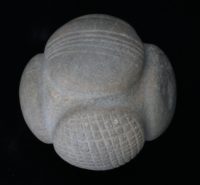 An intricately carved Neolithic stone ball discovered in the Ochil Hills near Sherriffmuir in Perthshire, central Scotland, will stay in its native soil after a fundraising campaign secured it for the Perth Museum and Art Gallery. The 4,000-year-old stone was declared Treasure Trove according to Scottish law and allocated to the Perth Museum, but because budget cuts have slashed its acquisitions budget, the museum had to raise money to secure it. The Perthshire Society of Natural Science opened an online crowd-funding campaign and was able to raise £1625 well before the March 26th deadline. A grant from the National Fund for Acquisitions chipped in matching funds.
An intricately carved Neolithic stone ball discovered in the Ochil Hills near Sherriffmuir in Perthshire, central Scotland, will stay in its native soil after a fundraising campaign secured it for the Perth Museum and Art Gallery. The 4,000-year-old stone was declared Treasure Trove according to Scottish law and allocated to the Perth Museum, but because budget cuts have slashed its acquisitions budget, the museum had to raise money to secure it. The Perthshire Society of Natural Science opened an online crowd-funding campaign and was able to raise £1625 well before the March 26th deadline. A grant from the National Fund for Acquisitions chipped in matching funds.
Stone balls carved in the Late Stone Age (around 3200 – 2500 BC) are a big thing in Scotland. Out of about 530 that have been found in Northern Europe, 520 of them were found in Scotland. More than a third of them are in the National Museums Scotland in Edinburgh. That the Sheriffmuir Ball will remain local is all the more significant because it is one of fewer than 50 of the known Neolithic balls to have decorative carving and it’s a particularly elaborate one. It’s also one of the most southernly balls ever found in Scotland.
Since the first one was discovered 150 years ago, archaeologists have debated what the purpose of the balls might have been. None of them have been found in or near burial, so they were not used as funerary offerings or grave goods. They could have been weapons, tools or status symbols, or perhaps a combination of any of those.
They are roughly the same size and while remaining circular in dimensions, they have been carved to have lobes or knobs. The ones that are decorated have spirals and curved carved into the surface. The Sheriffmuir Ball has a grid pattern on one lobe, five parallel lines on another and an off-center circle on a third.
You can explore it in the 3D model created by National Museums Scotland:
I rather like the idea that these are loom weights. Perhaps not your average loom weight, but that special one, the one that gets handed down, like granny’s teapot or quilt.
Most of the knobs here are bare, but the three marked ones seem to be all together.
Imagine the straight lines as representing the warp – the vertical threads that will need tensioning, such as with a loom weight. The circle seems to loop around three dents – which could be the loom weight, a kind of loom weight selfie, at one end of the warp threads. Finally, the other face shows the weft threads woven through the warp threads, to make the cloth.
It is probably not that, but it would be funny if it were actually a loom selfie 😉
A weapon would be my guess, a cord for spinning around the head; a close range device for warping your adversary up or to increase its velocity for down range impacts. The lobes would hold the cord in place
Great idea. I have used many different improvised loom weights in my weaving. This would be much more elegant than a bunch of washers strung together. Too bad looms and textiles don’t generally survive the wears and tears of time.
Or golf is a much older sport than we think. 😉
“They are usually round (rarely oval), of fairly uniform size at around 2.75 inches or 7 cm across, about the size of tennis balls or oranges, with 3 to 160 protruding knobs on the surface. They range from having no ornamentation but the knobs to extensive and highly varied engraved patterns”. – “Out of about 530 that have been found in Northern Europe, 520 of them were found in Scotland”
Of the 387 carved stone balls known in 1976, here the number of knobs -vs.- corresponding ball quantity:
———————-
03 knobs: 3
04 knobs: 43
05 knobs: 3
06 knobs: 193
07 knobs: 18
08 knobs: 9
09 knobs: 3
10 -55 kn.: 52
70-160 kn.: 14
Maybe they were used in Scottish ‘stone circle astronomy’, similar to those famous Bronze Age ‘Golden hats’:
———————-
“Since an exact knowledge of the solar year was of special interest for the determination of religiously important events such as the summer and winter solstices, if astronomical knowledge was depicted on the Golden Hats it would have been of high value to Bronze Age society. Whether the hats themselves were indeed used for determining such dates, or whether they even represented such knowledge, remains unknown. The functions hypothesized so far would permit the counting of temporal units of up to 57 months. A simple multiplication of such values could also permit the calculation of longer periods, e.g. metonic cycles.”
———————-
Solar vs. lunar months on a ‘Gold hat’, so maybe there were whole ‘sets’? What about trading-, warehousing- or taxing tokens, e.g.: ‘By next month 5 knobs of ‘Haggis’, please’?